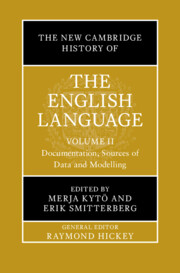Book contents
- The New Cambridge History of the English Language
- The New Cambridge History of the English Language
- The New Cambridge History of the English Language
- Copyright page
- Contents
- Figures
- Tables
- Contributors to Volume II
- General Preface
- Abbreviations for Corpora and Other Electronic Resources
- General Editor’s Introduction
- Introduction to Volume II
- Part I The Textual Record
- Part II Lighthouse Works and Authors
- Part III Genre and Medium in the Record
- 17 Grammatical Treatises in Early English
- 18 History Writing
- 19 The Language of Religious Texts
- 20 The Language of Courtroom Documents
- 21 Medical and Scientific Writing
- 22 The Language of Newspapers
- 23 ‘Bad Data’: The Case for Early Audio Records
- 24 Ego Documents in the History of English
- 25 Personal Letters in a Community Context
- 26 Women’s Voices in the History of English
- Part IV Modelling the Record: Methods and Theories
- Appendix: List of Corpora and Other Electronic Resources
- Index
- References
22 - The Language of Newspapers
from Part III - Genre and Medium in the Record
Published online by Cambridge University Press: 18 October 2025
- The New Cambridge History of the English Language
- The New Cambridge History of the English Language
- The New Cambridge History of the English Language
- Copyright page
- Contents
- Figures
- Tables
- Contributors to Volume II
- General Preface
- Abbreviations for Corpora and Other Electronic Resources
- General Editor’s Introduction
- Introduction to Volume II
- Part I The Textual Record
- Part II Lighthouse Works and Authors
- Part III Genre and Medium in the Record
- 17 Grammatical Treatises in Early English
- 18 History Writing
- 19 The Language of Religious Texts
- 20 The Language of Courtroom Documents
- 21 Medical and Scientific Writing
- 22 The Language of Newspapers
- 23 ‘Bad Data’: The Case for Early Audio Records
- 24 Ego Documents in the History of English
- 25 Personal Letters in a Community Context
- 26 Women’s Voices in the History of English
- Part IV Modelling the Record: Methods and Theories
- Appendix: List of Corpora and Other Electronic Resources
- Index
- References
Summary
This chapter examines key features of the language of print newspapers in Britain from the founding of the London Gazette in 1665 up until the present day. It describes significant milestones in the history of English newspapers, outlining major socio-historical, economic, cultural and technological developments which have had an impact on the emergence, diversification and professionalisation of this important mass medium. After an overview of the major subgenres found in these multi-text conglomerates – news, opinion and advertising – the focus is on news reports. The chapter outlines how the chronological mode of reporting news preferred in the first two hundred years of newspapers gave way to the inverted pyramid style of news narration, subsequently abandoned for more flexible models like the package approach in modern news discourse. Furthermore, this chapter provides insights into contemporary journalistic ideals and practices employed in positioning the paper and balancing information density and readership appeal.
Keywords
Information
- Type
- Chapter
- Information
- The New Cambridge History of the English LanguageDocumentation, Sources of Data and Modelling, pp. 534 - 558Publisher: Cambridge University PressPrint publication year: 2025
References
Accessibility standard: WCAG 2.0 A
Why this information is here
This section outlines the accessibility features of this content - including support for screen readers, full keyboard navigation and high-contrast display options. This may not be relevant for you.Accessibility Information
Content Navigation
Allows you to navigate directly to chapters, sections, or non‐text items through a linked table of contents, reducing the need for extensive scrolling.
Provides an interactive index, letting you go straight to where a term or subject appears in the text without manual searching.
Reading Order & Textual Equivalents
You will encounter all content (including footnotes, captions, etc.) in a clear, sequential flow, making it easier to follow with assistive tools like screen readers.
You get concise descriptions (for images, charts, or media clips), ensuring you do not miss crucial information when visual or audio elements are not accessible.
Visual Accessibility
You will still understand key ideas or prompts without relying solely on colour, which is especially helpful if you have colour vision deficiencies.
Structural and Technical Features
You gain clarity from ARIA (Accessible Rich Internet Applications) roles and attributes, as they help assistive technologies interpret how each part of the content functions.
